NURS 4001: Clinical Audit of Pressure Injury Care Quality
VerifiedAdded on 2022/09/18
|16
|3616
|32
Report
AI Summary
This clinical audit, conducted by a graduate nurse at Mackay Hospital, evaluates the quality of pressure injury care against the National Safety and Quality Health Service (NSQHS) standard number one: clinical governance. The audit, utilizing the Queensland Department of Health's audit tool, assessed nurses' knowledge and practices in the emergency ward. The report details the methodology, including location, duration, recruitment, ethical considerations, measurement tools, and data analysis. Findings reveal the knowledge levels of nurses, the quality of care provided, and areas for improvement. Recommendations are provided to enhance the care facility, focusing on patient safety and improved outcomes for elderly and immobile patients. The audit underscores the importance of continuous observation, implementation of changes, and adherence to national standards in pressure injury care. The results show the achievement of objectives and the need for improved training for nurses in this critical area of patient care.
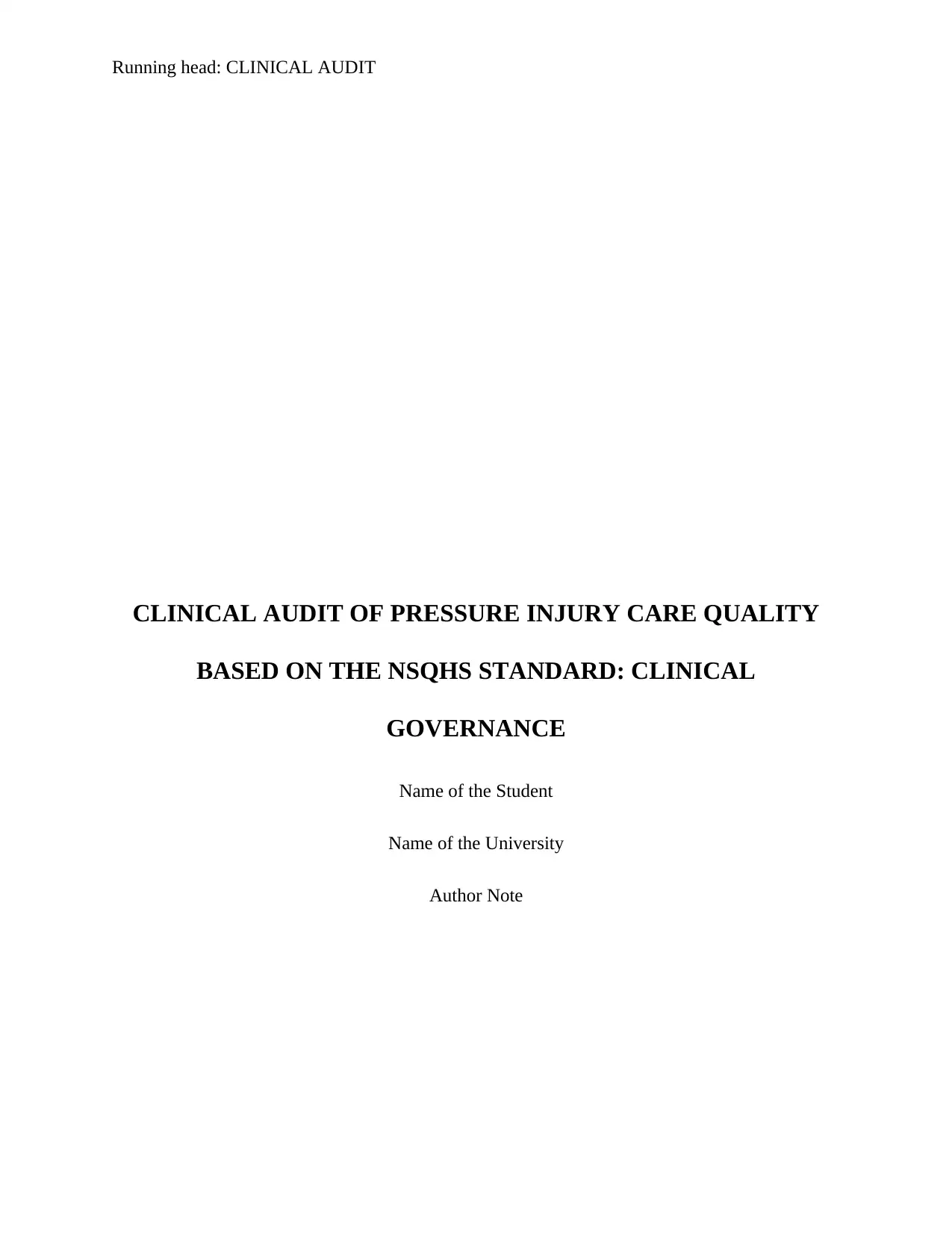
Running head: CLINICAL AUDIT
CLINICAL AUDIT OF PRESSURE INJURY CARE QUALITY
BASED ON THE NSQHS STANDARD: CLINICAL
GOVERNANCE
Name of the Student
Name of the University
Author Note
CLINICAL AUDIT OF PRESSURE INJURY CARE QUALITY
BASED ON THE NSQHS STANDARD: CLINICAL
GOVERNANCE
Name of the Student
Name of the University
Author Note
Paraphrase This Document
Need a fresh take? Get an instant paraphrase of this document with our AI Paraphraser
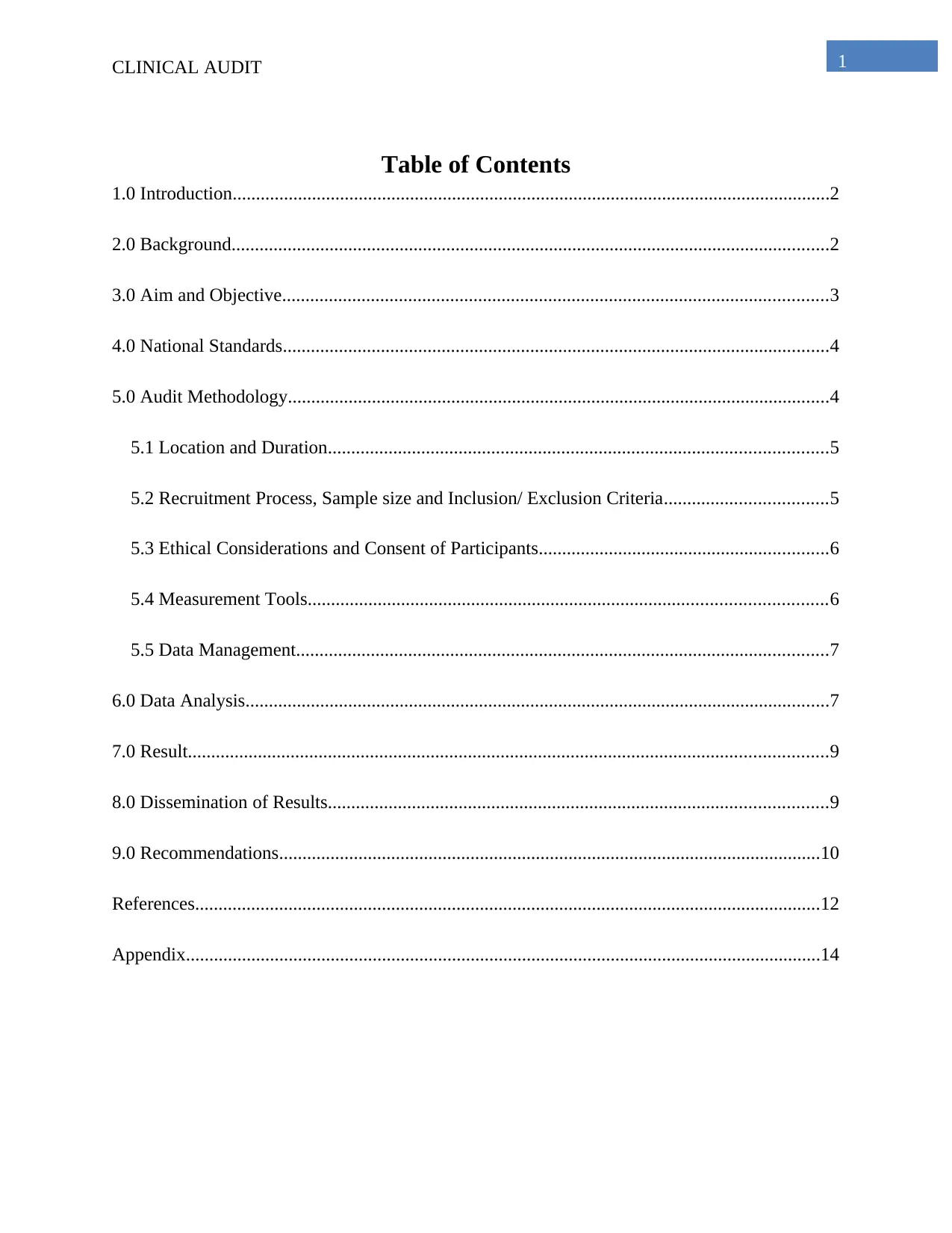
1CLINICAL AUDIT
Table of Contents
1.0 Introduction................................................................................................................................2
2.0 Background................................................................................................................................2
3.0 Aim and Objective.....................................................................................................................3
4.0 National Standards.....................................................................................................................4
5.0 Audit Methodology....................................................................................................................4
5.1 Location and Duration...........................................................................................................5
5.2 Recruitment Process, Sample size and Inclusion/ Exclusion Criteria...................................5
5.3 Ethical Considerations and Consent of Participants..............................................................6
5.4 Measurement Tools...............................................................................................................6
5.5 Data Management..................................................................................................................7
6.0 Data Analysis.............................................................................................................................7
7.0 Result.........................................................................................................................................9
8.0 Dissemination of Results...........................................................................................................9
9.0 Recommendations....................................................................................................................10
References......................................................................................................................................12
Appendix........................................................................................................................................14
Table of Contents
1.0 Introduction................................................................................................................................2
2.0 Background................................................................................................................................2
3.0 Aim and Objective.....................................................................................................................3
4.0 National Standards.....................................................................................................................4
5.0 Audit Methodology....................................................................................................................4
5.1 Location and Duration...........................................................................................................5
5.2 Recruitment Process, Sample size and Inclusion/ Exclusion Criteria...................................5
5.3 Ethical Considerations and Consent of Participants..............................................................6
5.4 Measurement Tools...............................................................................................................6
5.5 Data Management..................................................................................................................7
6.0 Data Analysis.............................................................................................................................7
7.0 Result.........................................................................................................................................9
8.0 Dissemination of Results...........................................................................................................9
9.0 Recommendations....................................................................................................................10
References......................................................................................................................................12
Appendix........................................................................................................................................14
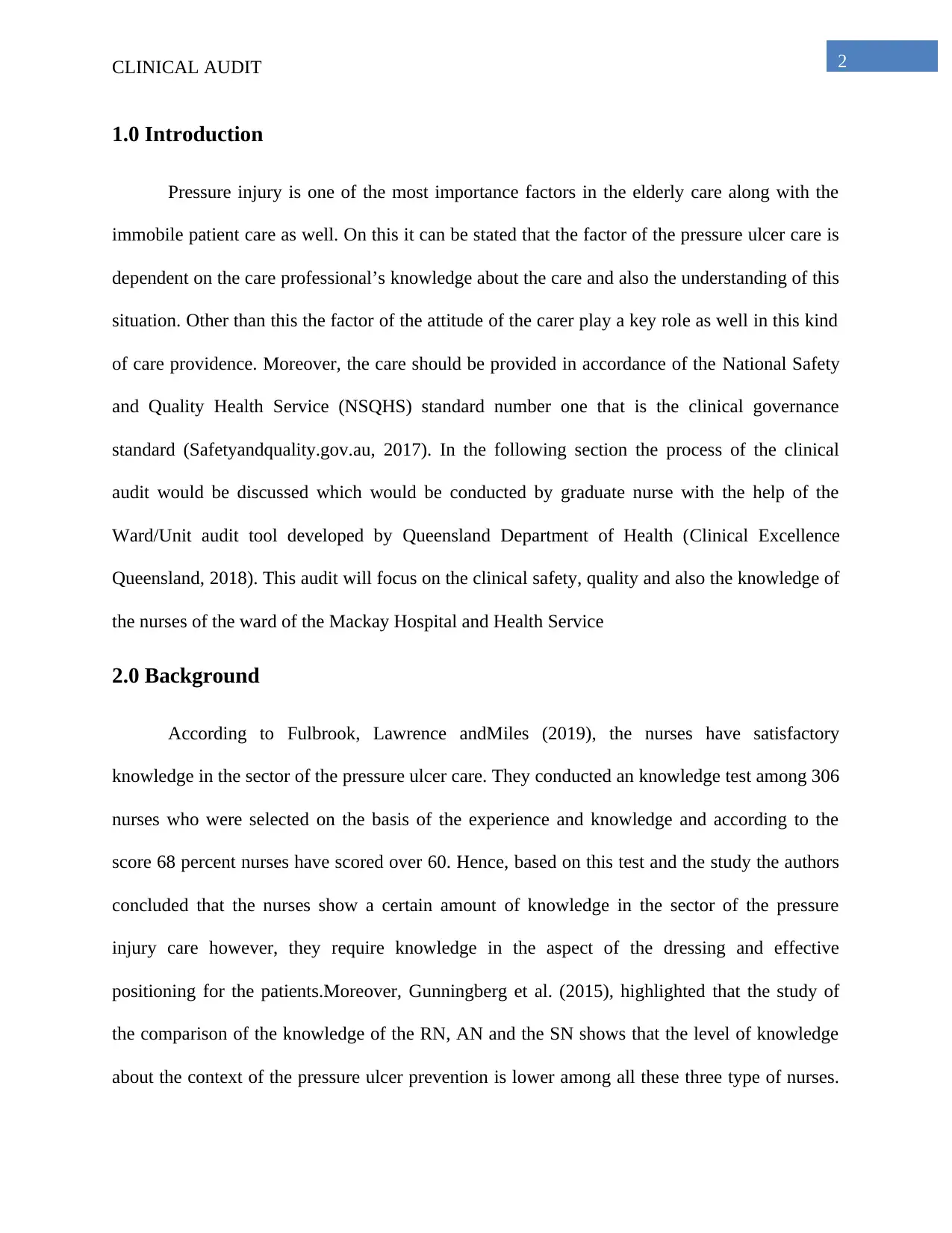
2CLINICAL AUDIT
1.0 Introduction
Pressure injury is one of the most importance factors in the elderly care along with the
immobile patient care as well. On this it can be stated that the factor of the pressure ulcer care is
dependent on the care professional’s knowledge about the care and also the understanding of this
situation. Other than this the factor of the attitude of the carer play a key role as well in this kind
of care providence. Moreover, the care should be provided in accordance of the National Safety
and Quality Health Service (NSQHS) standard number one that is the clinical governance
standard (Safetyandquality.gov.au, 2017). In the following section the process of the clinical
audit would be discussed which would be conducted by graduate nurse with the help of the
Ward/Unit audit tool developed by Queensland Department of Health (Clinical Excellence
Queensland, 2018). This audit will focus on the clinical safety, quality and also the knowledge of
the nurses of the ward of the Mackay Hospital and Health Service
2.0 Background
According to Fulbrook, Lawrence andMiles (2019), the nurses have satisfactory
knowledge in the sector of the pressure ulcer care. They conducted an knowledge test among 306
nurses who were selected on the basis of the experience and knowledge and according to the
score 68 percent nurses have scored over 60. Hence, based on this test and the study the authors
concluded that the nurses show a certain amount of knowledge in the sector of the pressure
injury care however, they require knowledge in the aspect of the dressing and effective
positioning for the patients.Moreover, Gunningberg et al. (2015), highlighted that the study of
the comparison of the knowledge of the RN, AN and the SN shows that the level of knowledge
about the context of the pressure ulcer prevention is lower among all these three type of nurses.
1.0 Introduction
Pressure injury is one of the most importance factors in the elderly care along with the
immobile patient care as well. On this it can be stated that the factor of the pressure ulcer care is
dependent on the care professional’s knowledge about the care and also the understanding of this
situation. Other than this the factor of the attitude of the carer play a key role as well in this kind
of care providence. Moreover, the care should be provided in accordance of the National Safety
and Quality Health Service (NSQHS) standard number one that is the clinical governance
standard (Safetyandquality.gov.au, 2017). In the following section the process of the clinical
audit would be discussed which would be conducted by graduate nurse with the help of the
Ward/Unit audit tool developed by Queensland Department of Health (Clinical Excellence
Queensland, 2018). This audit will focus on the clinical safety, quality and also the knowledge of
the nurses of the ward of the Mackay Hospital and Health Service
2.0 Background
According to Fulbrook, Lawrence andMiles (2019), the nurses have satisfactory
knowledge in the sector of the pressure ulcer care. They conducted an knowledge test among 306
nurses who were selected on the basis of the experience and knowledge and according to the
score 68 percent nurses have scored over 60. Hence, based on this test and the study the authors
concluded that the nurses show a certain amount of knowledge in the sector of the pressure
injury care however, they require knowledge in the aspect of the dressing and effective
positioning for the patients.Moreover, Gunningberg et al. (2015), highlighted that the study of
the comparison of the knowledge of the RN, AN and the SN shows that the level of knowledge
about the context of the pressure ulcer prevention is lower among all these three type of nurses.
⊘ This is a preview!⊘
Do you want full access?
Subscribe today to unlock all pages.

Trusted by 1+ million students worldwide
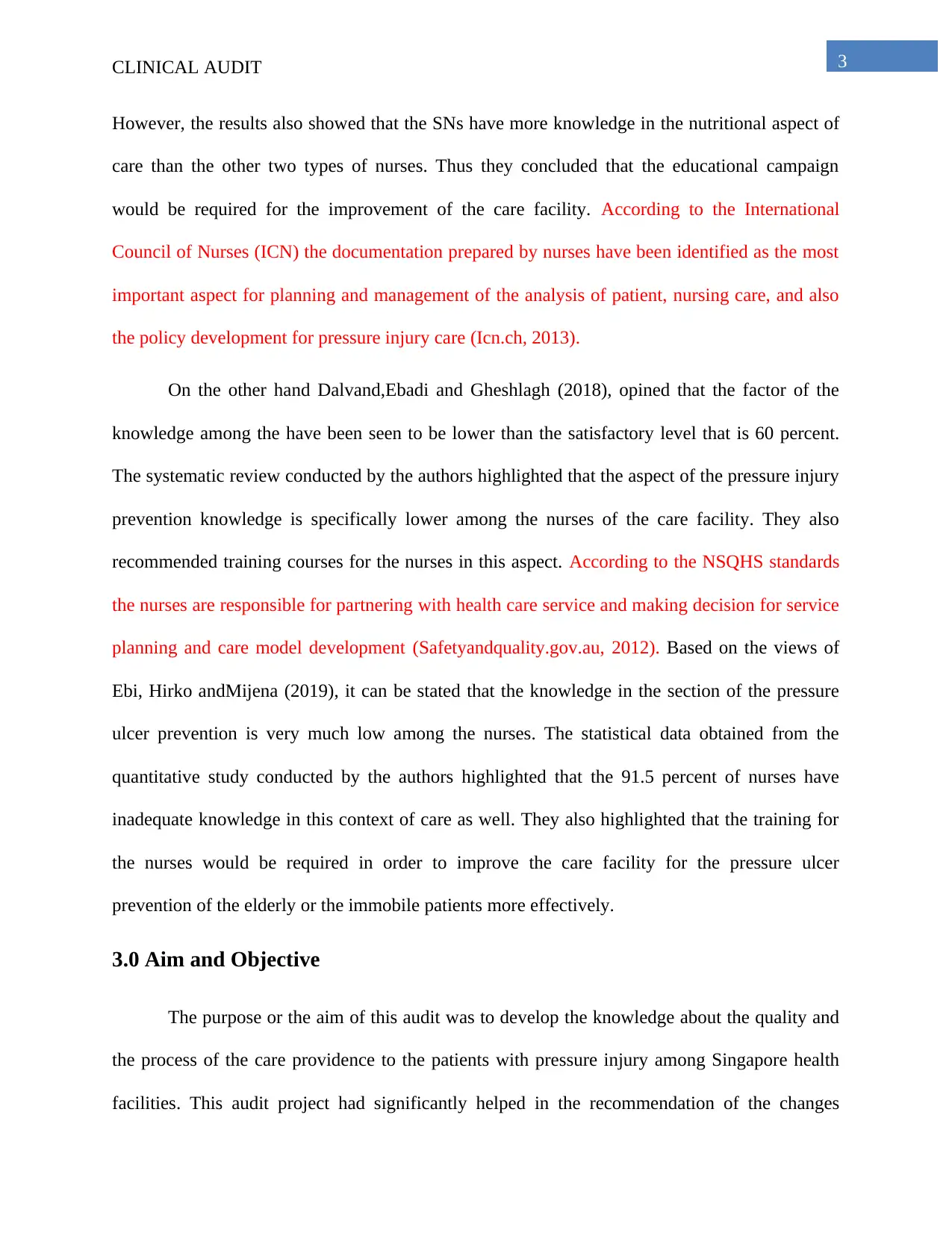
3CLINICAL AUDIT
However, the results also showed that the SNs have more knowledge in the nutritional aspect of
care than the other two types of nurses. Thus they concluded that the educational campaign
would be required for the improvement of the care facility. According to the International
Council of Nurses (ICN) the documentation prepared by nurses have been identified as the most
important aspect for planning and management of the analysis of patient, nursing care, and also
the policy development for pressure injury care (Icn.ch, 2013).
On the other hand Dalvand,Ebadi and Gheshlagh (2018), opined that the factor of the
knowledge among the have been seen to be lower than the satisfactory level that is 60 percent.
The systematic review conducted by the authors highlighted that the aspect of the pressure injury
prevention knowledge is specifically lower among the nurses of the care facility. They also
recommended training courses for the nurses in this aspect. According to the NSQHS standards
the nurses are responsible for partnering with health care service and making decision for service
planning and care model development (Safetyandquality.gov.au, 2012). Based on the views of
Ebi, Hirko andMijena (2019), it can be stated that the knowledge in the section of the pressure
ulcer prevention is very much low among the nurses. The statistical data obtained from the
quantitative study conducted by the authors highlighted that the 91.5 percent of nurses have
inadequate knowledge in this context of care as well. They also highlighted that the training for
the nurses would be required in order to improve the care facility for the pressure ulcer
prevention of the elderly or the immobile patients more effectively.
3.0 Aim and Objective
The purpose or the aim of this audit was to develop the knowledge about the quality and
the process of the care providence to the patients with pressure injury among Singapore health
facilities. This audit project had significantly helped in the recommendation of the changes
However, the results also showed that the SNs have more knowledge in the nutritional aspect of
care than the other two types of nurses. Thus they concluded that the educational campaign
would be required for the improvement of the care facility. According to the International
Council of Nurses (ICN) the documentation prepared by nurses have been identified as the most
important aspect for planning and management of the analysis of patient, nursing care, and also
the policy development for pressure injury care (Icn.ch, 2013).
On the other hand Dalvand,Ebadi and Gheshlagh (2018), opined that the factor of the
knowledge among the have been seen to be lower than the satisfactory level that is 60 percent.
The systematic review conducted by the authors highlighted that the aspect of the pressure injury
prevention knowledge is specifically lower among the nurses of the care facility. They also
recommended training courses for the nurses in this aspect. According to the NSQHS standards
the nurses are responsible for partnering with health care service and making decision for service
planning and care model development (Safetyandquality.gov.au, 2012). Based on the views of
Ebi, Hirko andMijena (2019), it can be stated that the knowledge in the section of the pressure
ulcer prevention is very much low among the nurses. The statistical data obtained from the
quantitative study conducted by the authors highlighted that the 91.5 percent of nurses have
inadequate knowledge in this context of care as well. They also highlighted that the training for
the nurses would be required in order to improve the care facility for the pressure ulcer
prevention of the elderly or the immobile patients more effectively.
3.0 Aim and Objective
The purpose or the aim of this audit was to develop the knowledge about the quality and
the process of the care providence to the patients with pressure injury among Singapore health
facilities. This audit project had significantly helped in the recommendation of the changes
Paraphrase This Document
Need a fresh take? Get an instant paraphrase of this document with our AI Paraphraser
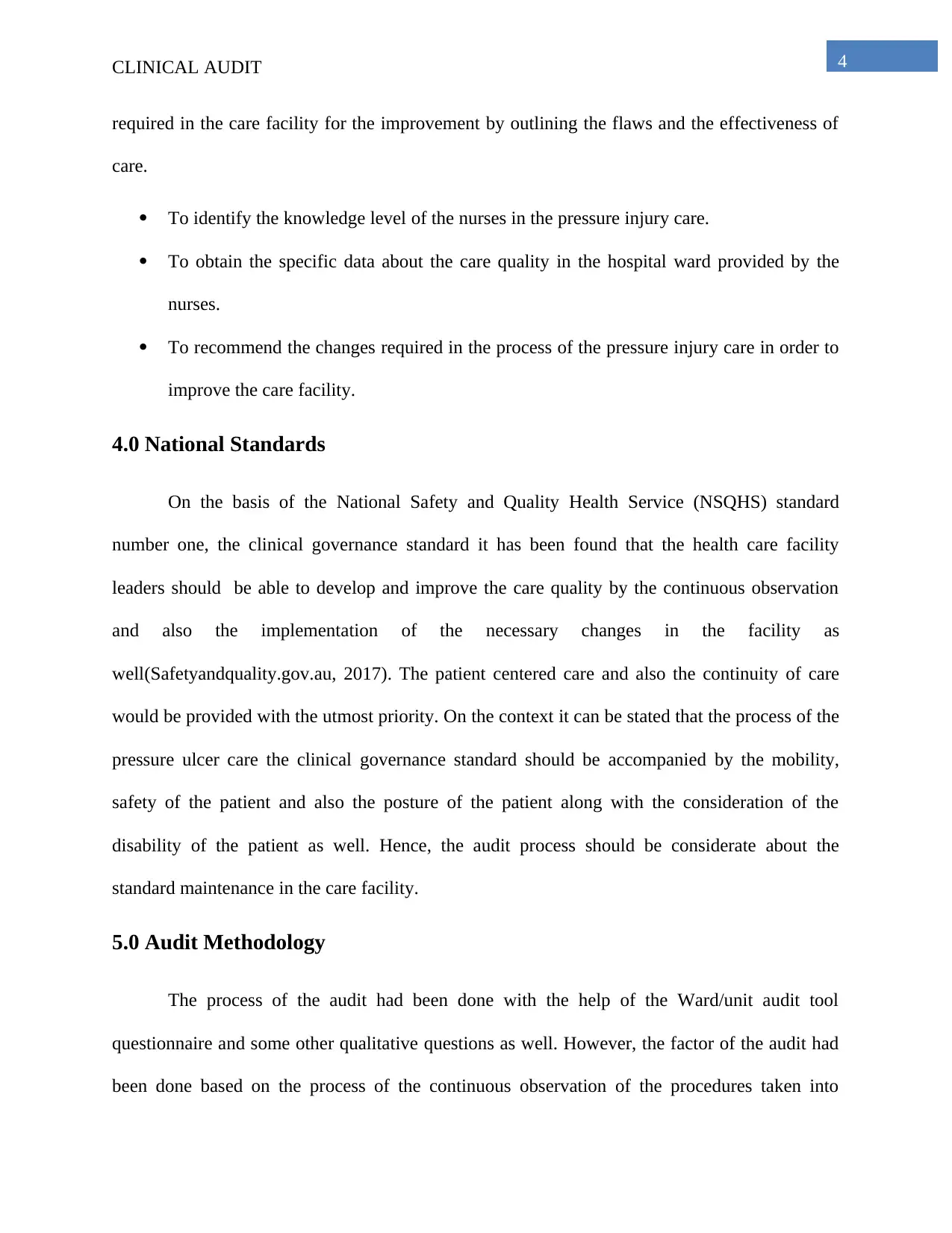
4CLINICAL AUDIT
required in the care facility for the improvement by outlining the flaws and the effectiveness of
care.
To identify the knowledge level of the nurses in the pressure injury care.
To obtain the specific data about the care quality in the hospital ward provided by the
nurses.
To recommend the changes required in the process of the pressure injury care in order to
improve the care facility.
4.0 National Standards
On the basis of the National Safety and Quality Health Service (NSQHS) standard
number one, the clinical governance standard it has been found that the health care facility
leaders should be able to develop and improve the care quality by the continuous observation
and also the implementation of the necessary changes in the facility as
well(Safetyandquality.gov.au, 2017). The patient centered care and also the continuity of care
would be provided with the utmost priority. On the context it can be stated that the process of the
pressure ulcer care the clinical governance standard should be accompanied by the mobility,
safety of the patient and also the posture of the patient along with the consideration of the
disability of the patient as well. Hence, the audit process should be considerate about the
standard maintenance in the care facility.
5.0 Audit Methodology
The process of the audit had been done with the help of the Ward/unit audit tool
questionnaire and some other qualitative questions as well. However, the factor of the audit had
been done based on the process of the continuous observation of the procedures taken into
required in the care facility for the improvement by outlining the flaws and the effectiveness of
care.
To identify the knowledge level of the nurses in the pressure injury care.
To obtain the specific data about the care quality in the hospital ward provided by the
nurses.
To recommend the changes required in the process of the pressure injury care in order to
improve the care facility.
4.0 National Standards
On the basis of the National Safety and Quality Health Service (NSQHS) standard
number one, the clinical governance standard it has been found that the health care facility
leaders should be able to develop and improve the care quality by the continuous observation
and also the implementation of the necessary changes in the facility as
well(Safetyandquality.gov.au, 2017). The patient centered care and also the continuity of care
would be provided with the utmost priority. On the context it can be stated that the process of the
pressure ulcer care the clinical governance standard should be accompanied by the mobility,
safety of the patient and also the posture of the patient along with the consideration of the
disability of the patient as well. Hence, the audit process should be considerate about the
standard maintenance in the care facility.
5.0 Audit Methodology
The process of the audit had been done with the help of the Ward/unit audit tool
questionnaire and some other qualitative questions as well. However, the factor of the audit had
been done based on the process of the continuous observation of the procedures taken into
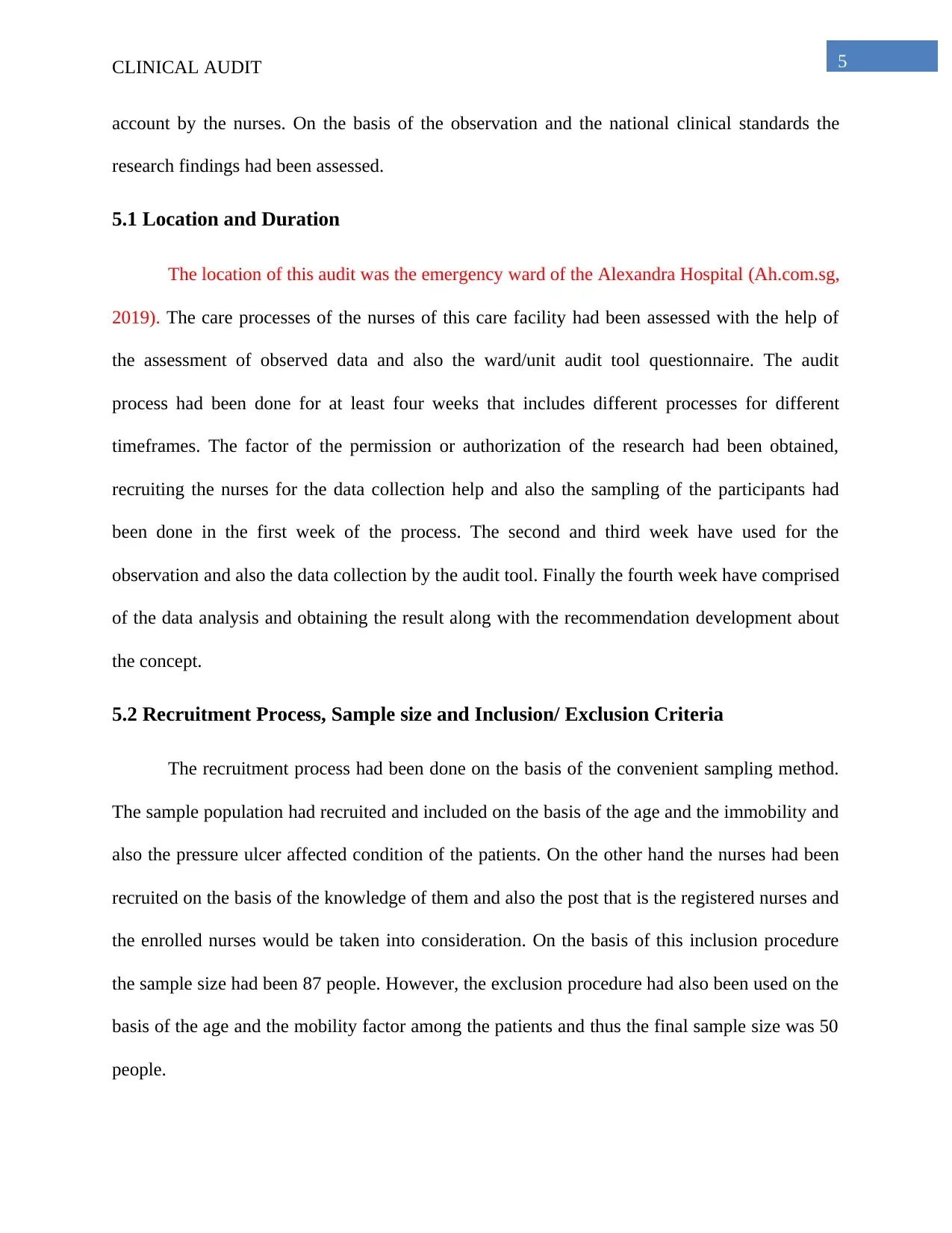
5CLINICAL AUDIT
account by the nurses. On the basis of the observation and the national clinical standards the
research findings had been assessed.
5.1 Location and Duration
The location of this audit was the emergency ward of the Alexandra Hospital (Ah.com.sg,
2019). The care processes of the nurses of this care facility had been assessed with the help of
the assessment of observed data and also the ward/unit audit tool questionnaire. The audit
process had been done for at least four weeks that includes different processes for different
timeframes. The factor of the permission or authorization of the research had been obtained,
recruiting the nurses for the data collection help and also the sampling of the participants had
been done in the first week of the process. The second and third week have used for the
observation and also the data collection by the audit tool. Finally the fourth week have comprised
of the data analysis and obtaining the result along with the recommendation development about
the concept.
5.2 Recruitment Process, Sample size and Inclusion/ Exclusion Criteria
The recruitment process had been done on the basis of the convenient sampling method.
The sample population had recruited and included on the basis of the age and the immobility and
also the pressure ulcer affected condition of the patients. On the other hand the nurses had been
recruited on the basis of the knowledge of them and also the post that is the registered nurses and
the enrolled nurses would be taken into consideration. On the basis of this inclusion procedure
the sample size had been 87 people. However, the exclusion procedure had also been used on the
basis of the age and the mobility factor among the patients and thus the final sample size was 50
people.
account by the nurses. On the basis of the observation and the national clinical standards the
research findings had been assessed.
5.1 Location and Duration
The location of this audit was the emergency ward of the Alexandra Hospital (Ah.com.sg,
2019). The care processes of the nurses of this care facility had been assessed with the help of
the assessment of observed data and also the ward/unit audit tool questionnaire. The audit
process had been done for at least four weeks that includes different processes for different
timeframes. The factor of the permission or authorization of the research had been obtained,
recruiting the nurses for the data collection help and also the sampling of the participants had
been done in the first week of the process. The second and third week have used for the
observation and also the data collection by the audit tool. Finally the fourth week have comprised
of the data analysis and obtaining the result along with the recommendation development about
the concept.
5.2 Recruitment Process, Sample size and Inclusion/ Exclusion Criteria
The recruitment process had been done on the basis of the convenient sampling method.
The sample population had recruited and included on the basis of the age and the immobility and
also the pressure ulcer affected condition of the patients. On the other hand the nurses had been
recruited on the basis of the knowledge of them and also the post that is the registered nurses and
the enrolled nurses would be taken into consideration. On the basis of this inclusion procedure
the sample size had been 87 people. However, the exclusion procedure had also been used on the
basis of the age and the mobility factor among the patients and thus the final sample size was 50
people.
⊘ This is a preview!⊘
Do you want full access?
Subscribe today to unlock all pages.

Trusted by 1+ million students worldwide
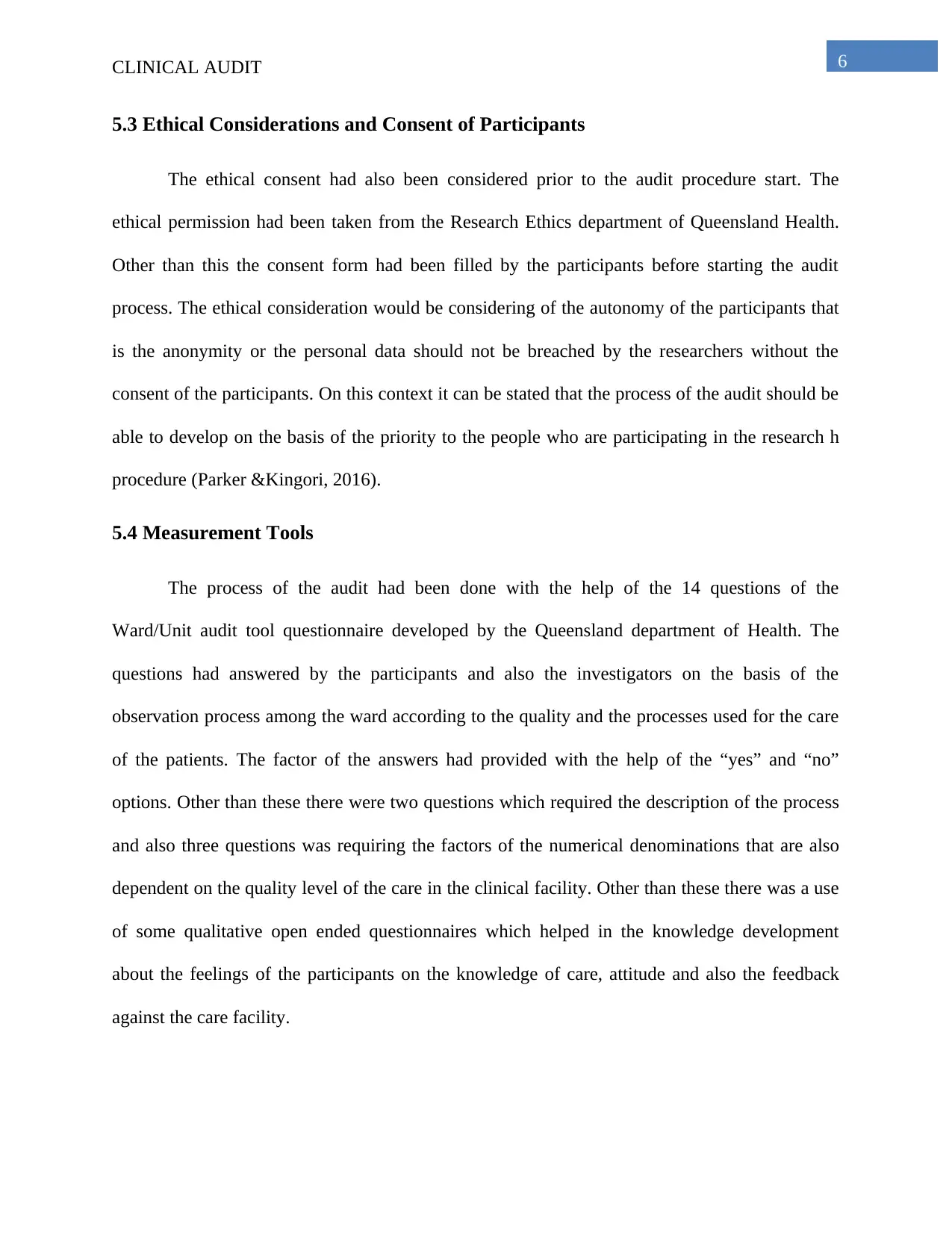
6CLINICAL AUDIT
5.3 Ethical Considerations and Consent of Participants
The ethical consent had also been considered prior to the audit procedure start. The
ethical permission had been taken from the Research Ethics department of Queensland Health.
Other than this the consent form had been filled by the participants before starting the audit
process. The ethical consideration would be considering of the autonomy of the participants that
is the anonymity or the personal data should not be breached by the researchers without the
consent of the participants. On this context it can be stated that the process of the audit should be
able to develop on the basis of the priority to the people who are participating in the research h
procedure (Parker &Kingori, 2016).
5.4 Measurement Tools
The process of the audit had been done with the help of the 14 questions of the
Ward/Unit audit tool questionnaire developed by the Queensland department of Health. The
questions had answered by the participants and also the investigators on the basis of the
observation process among the ward according to the quality and the processes used for the care
of the patients. The factor of the answers had provided with the help of the “yes” and “no”
options. Other than these there were two questions which required the description of the process
and also three questions was requiring the factors of the numerical denominations that are also
dependent on the quality level of the care in the clinical facility. Other than these there was a use
of some qualitative open ended questionnaires which helped in the knowledge development
about the feelings of the participants on the knowledge of care, attitude and also the feedback
against the care facility.
5.3 Ethical Considerations and Consent of Participants
The ethical consent had also been considered prior to the audit procedure start. The
ethical permission had been taken from the Research Ethics department of Queensland Health.
Other than this the consent form had been filled by the participants before starting the audit
process. The ethical consideration would be considering of the autonomy of the participants that
is the anonymity or the personal data should not be breached by the researchers without the
consent of the participants. On this context it can be stated that the process of the audit should be
able to develop on the basis of the priority to the people who are participating in the research h
procedure (Parker &Kingori, 2016).
5.4 Measurement Tools
The process of the audit had been done with the help of the 14 questions of the
Ward/Unit audit tool questionnaire developed by the Queensland department of Health. The
questions had answered by the participants and also the investigators on the basis of the
observation process among the ward according to the quality and the processes used for the care
of the patients. The factor of the answers had provided with the help of the “yes” and “no”
options. Other than these there were two questions which required the description of the process
and also three questions was requiring the factors of the numerical denominations that are also
dependent on the quality level of the care in the clinical facility. Other than these there was a use
of some qualitative open ended questionnaires which helped in the knowledge development
about the feelings of the participants on the knowledge of care, attitude and also the feedback
against the care facility.
Paraphrase This Document
Need a fresh take? Get an instant paraphrase of this document with our AI Paraphraser
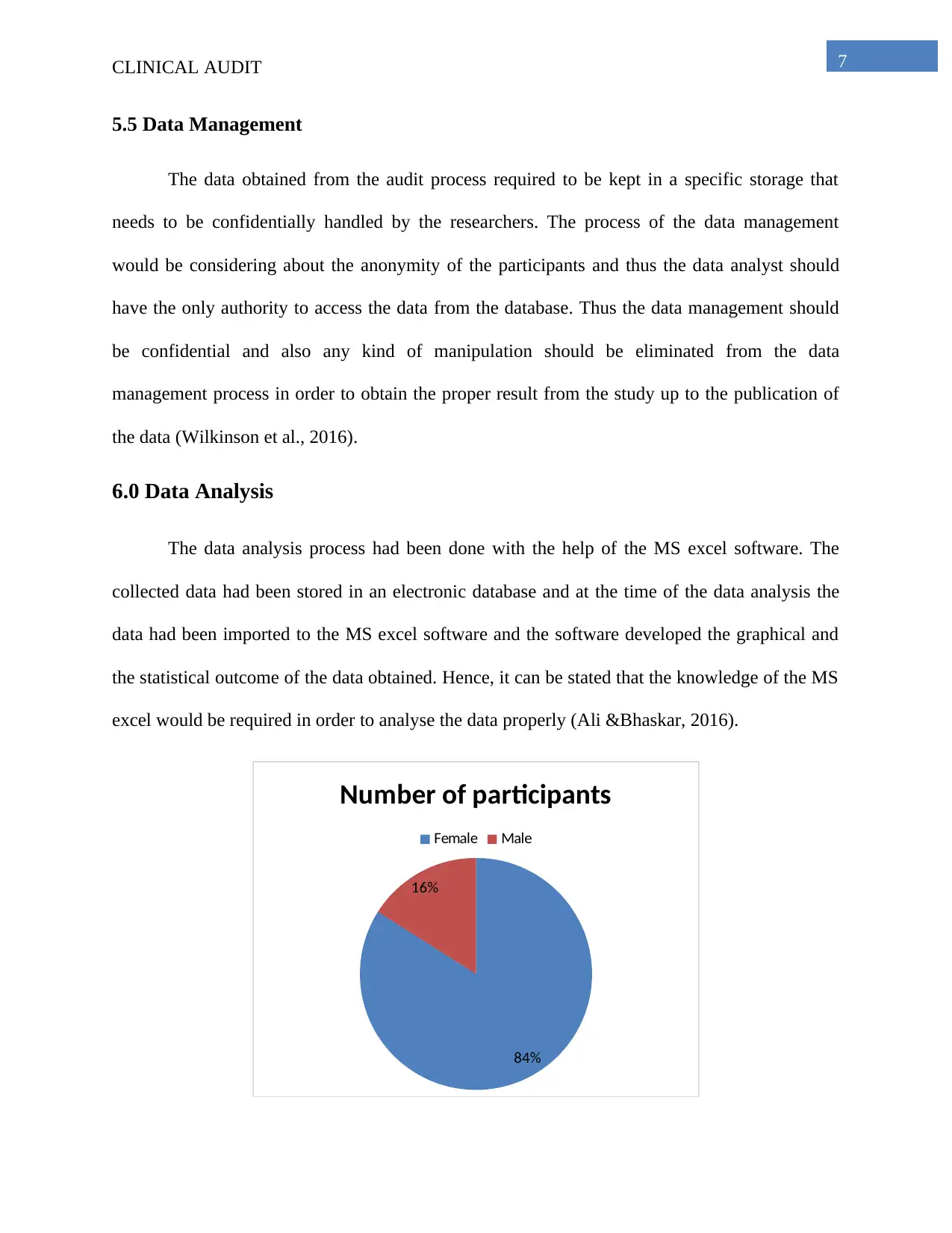
7CLINICAL AUDIT
5.5 Data Management
The data obtained from the audit process required to be kept in a specific storage that
needs to be confidentially handled by the researchers. The process of the data management
would be considering about the anonymity of the participants and thus the data analyst should
have the only authority to access the data from the database. Thus the data management should
be confidential and also any kind of manipulation should be eliminated from the data
management process in order to obtain the proper result from the study up to the publication of
the data (Wilkinson et al., 2016).
6.0 Data Analysis
The data analysis process had been done with the help of the MS excel software. The
collected data had been stored in an electronic database and at the time of the data analysis the
data had been imported to the MS excel software and the software developed the graphical and
the statistical outcome of the data obtained. Hence, it can be stated that the knowledge of the MS
excel would be required in order to analyse the data properly (Ali &Bhaskar, 2016).
84%
16%
Number of participants
Female Male
5.5 Data Management
The data obtained from the audit process required to be kept in a specific storage that
needs to be confidentially handled by the researchers. The process of the data management
would be considering about the anonymity of the participants and thus the data analyst should
have the only authority to access the data from the database. Thus the data management should
be confidential and also any kind of manipulation should be eliminated from the data
management process in order to obtain the proper result from the study up to the publication of
the data (Wilkinson et al., 2016).
6.0 Data Analysis
The data analysis process had been done with the help of the MS excel software. The
collected data had been stored in an electronic database and at the time of the data analysis the
data had been imported to the MS excel software and the software developed the graphical and
the statistical outcome of the data obtained. Hence, it can be stated that the knowledge of the MS
excel would be required in order to analyse the data properly (Ali &Bhaskar, 2016).
84%
16%
Number of participants
Female Male
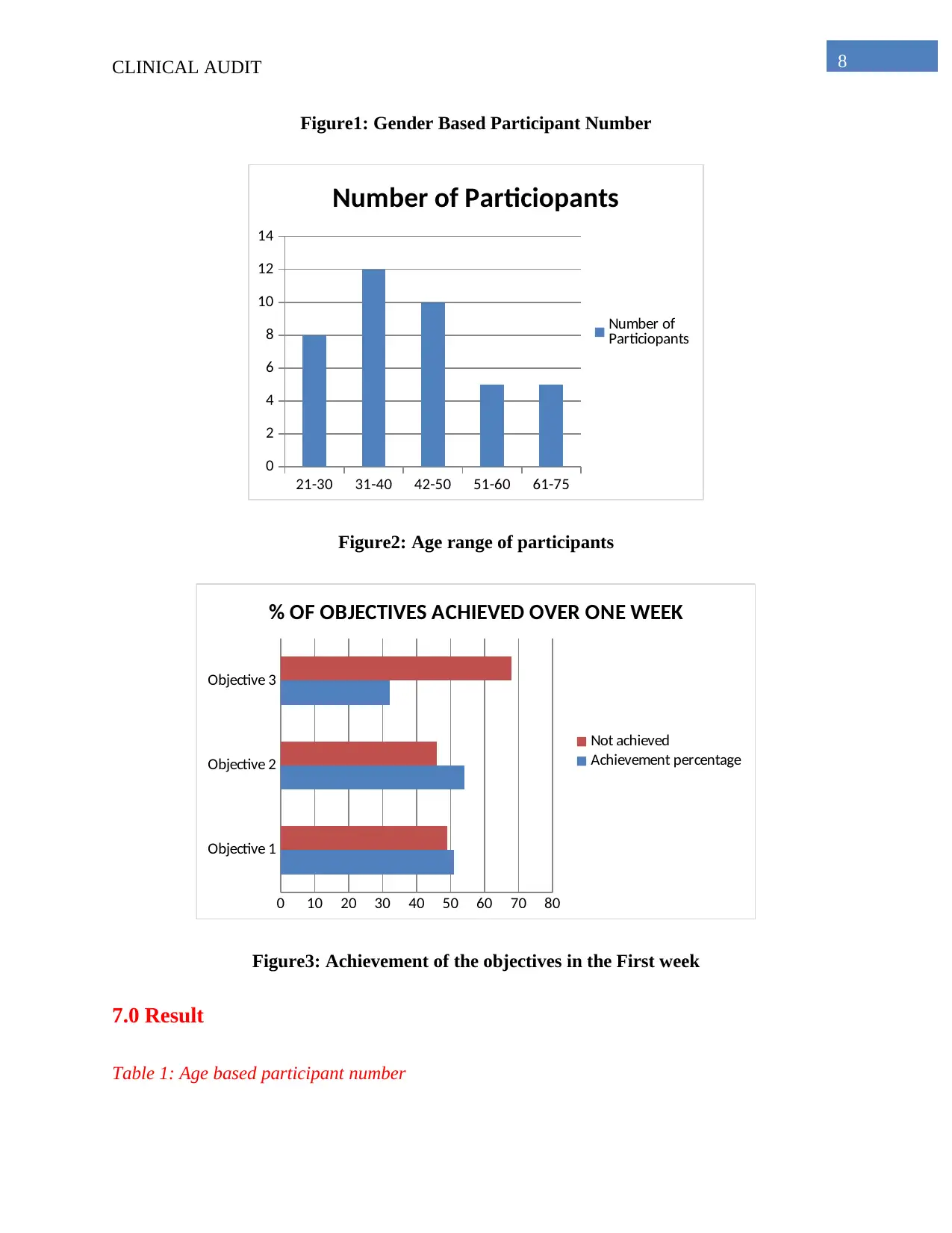
8CLINICAL AUDIT
Figure1: Gender Based Participant Number
21-30 31-40 42-50 51-60 61-75
0
2
4
6
8
10
12
14
Number of Particiopants
Number of
Particiopants
Figure2: Age range of participants
Objective 1
Objective 2
Objective 3
0 10 20 30 40 50 60 70 80
% OF OBJECTIVES ACHIEVED OVER ONE WEEK
Not achieved
Achievement percentage
Figure3: Achievement of the objectives in the First week
7.0 Result
Table 1: Age based participant number
Figure1: Gender Based Participant Number
21-30 31-40 42-50 51-60 61-75
0
2
4
6
8
10
12
14
Number of Particiopants
Number of
Particiopants
Figure2: Age range of participants
Objective 1
Objective 2
Objective 3
0 10 20 30 40 50 60 70 80
% OF OBJECTIVES ACHIEVED OVER ONE WEEK
Not achieved
Achievement percentage
Figure3: Achievement of the objectives in the First week
7.0 Result
Table 1: Age based participant number
⊘ This is a preview!⊘
Do you want full access?
Subscribe today to unlock all pages.

Trusted by 1+ million students worldwide
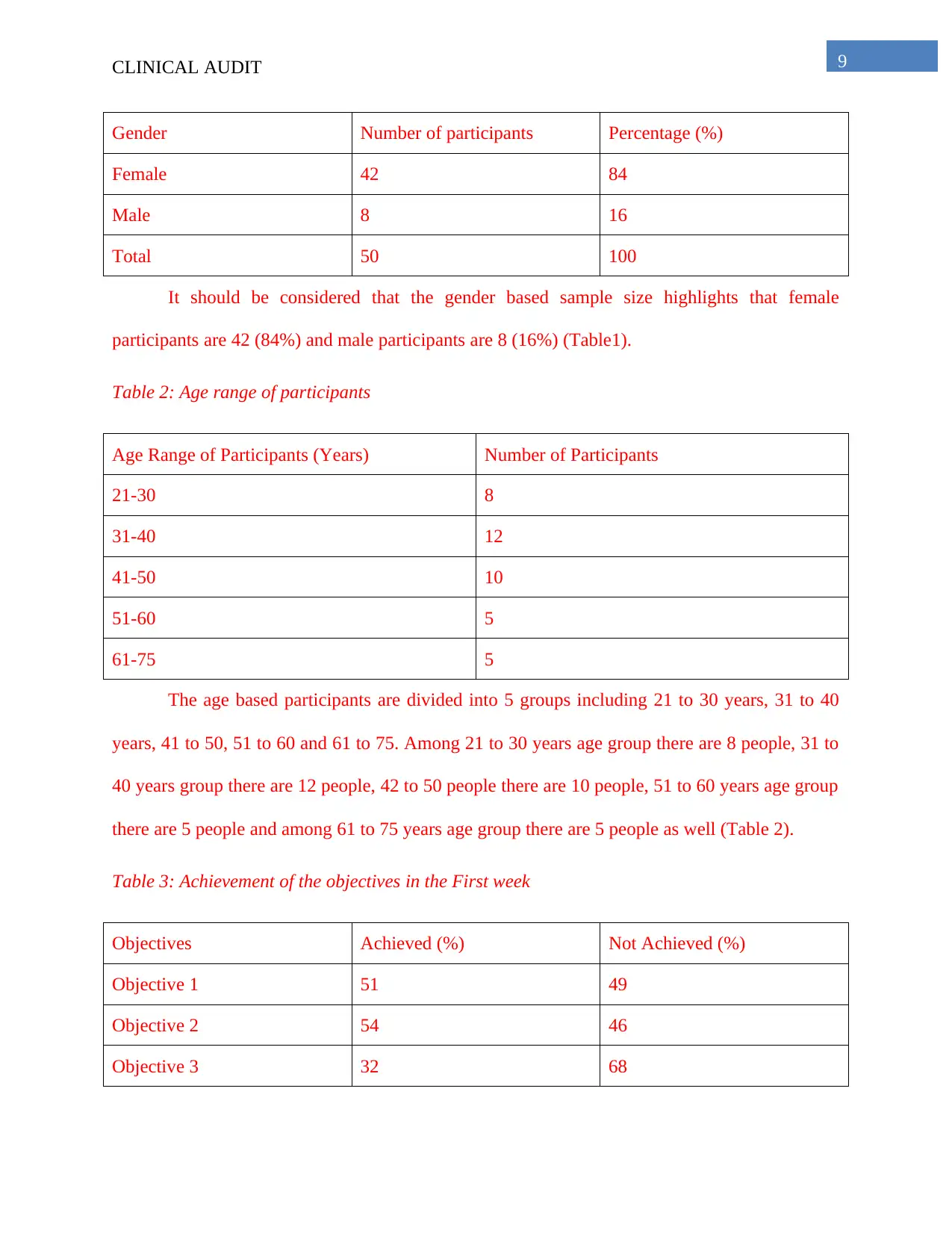
9CLINICAL AUDIT
Gender Number of participants Percentage (%)
Female 42 84
Male 8 16
Total 50 100
It should be considered that the gender based sample size highlights that female
participants are 42 (84%) and male participants are 8 (16%) (Table1).
Table 2: Age range of participants
Age Range of Participants (Years) Number of Participants
21-30 8
31-40 12
41-50 10
51-60 5
61-75 5
The age based participants are divided into 5 groups including 21 to 30 years, 31 to 40
years, 41 to 50, 51 to 60 and 61 to 75. Among 21 to 30 years age group there are 8 people, 31 to
40 years group there are 12 people, 42 to 50 people there are 10 people, 51 to 60 years age group
there are 5 people and among 61 to 75 years age group there are 5 people as well (Table 2).
Table 3: Achievement of the objectives in the First week
Objectives Achieved (%) Not Achieved (%)
Objective 1 51 49
Objective 2 54 46
Objective 3 32 68
Gender Number of participants Percentage (%)
Female 42 84
Male 8 16
Total 50 100
It should be considered that the gender based sample size highlights that female
participants are 42 (84%) and male participants are 8 (16%) (Table1).
Table 2: Age range of participants
Age Range of Participants (Years) Number of Participants
21-30 8
31-40 12
41-50 10
51-60 5
61-75 5
The age based participants are divided into 5 groups including 21 to 30 years, 31 to 40
years, 41 to 50, 51 to 60 and 61 to 75. Among 21 to 30 years age group there are 8 people, 31 to
40 years group there are 12 people, 42 to 50 people there are 10 people, 51 to 60 years age group
there are 5 people and among 61 to 75 years age group there are 5 people as well (Table 2).
Table 3: Achievement of the objectives in the First week
Objectives Achieved (%) Not Achieved (%)
Objective 1 51 49
Objective 2 54 46
Objective 3 32 68
Paraphrase This Document
Need a fresh take? Get an instant paraphrase of this document with our AI Paraphraser
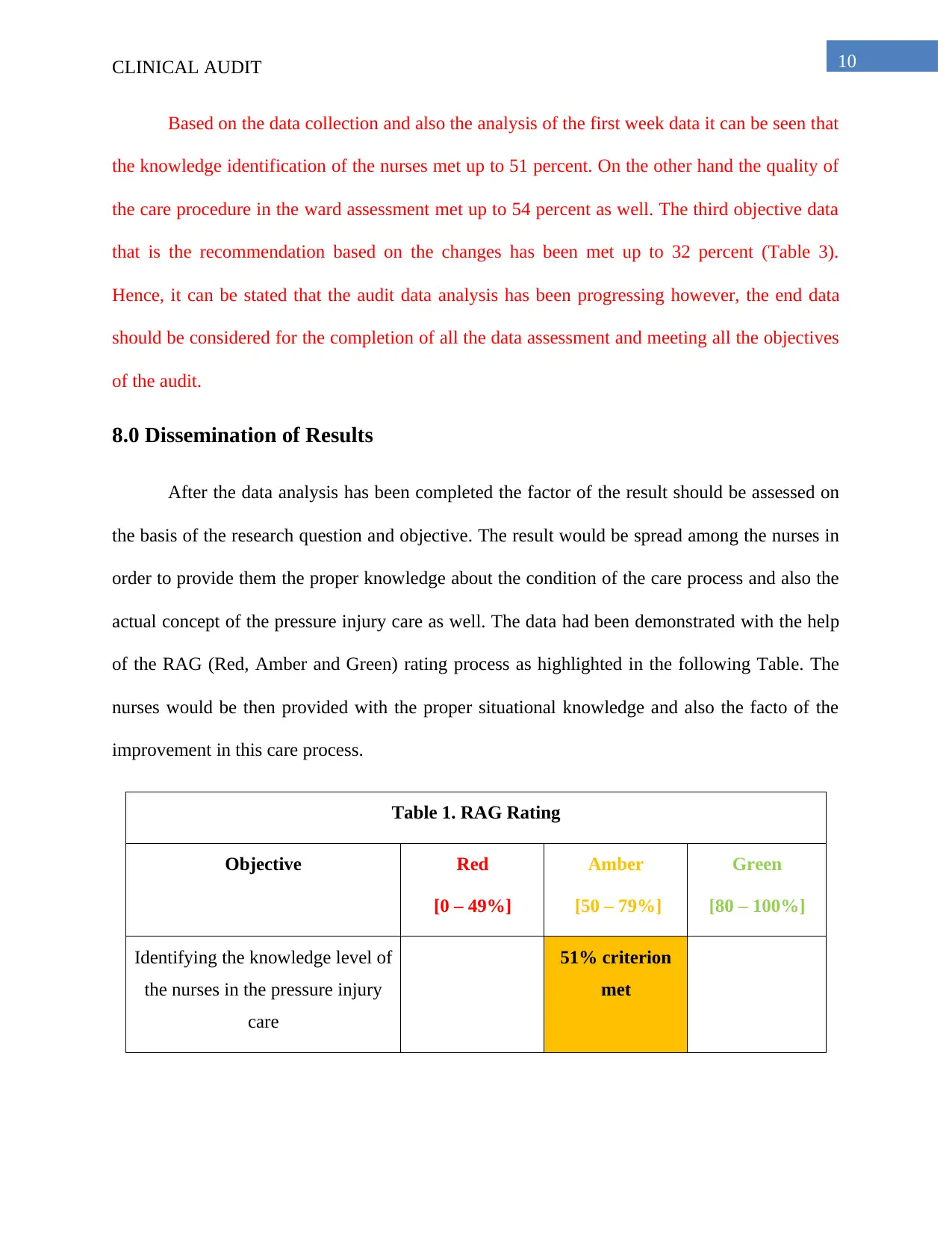
10CLINICAL AUDIT
Based on the data collection and also the analysis of the first week data it can be seen that
the knowledge identification of the nurses met up to 51 percent. On the other hand the quality of
the care procedure in the ward assessment met up to 54 percent as well. The third objective data
that is the recommendation based on the changes has been met up to 32 percent (Table 3).
Hence, it can be stated that the audit data analysis has been progressing however, the end data
should be considered for the completion of all the data assessment and meeting all the objectives
of the audit.
8.0 Dissemination of Results
After the data analysis has been completed the factor of the result should be assessed on
the basis of the research question and objective. The result would be spread among the nurses in
order to provide them the proper knowledge about the condition of the care process and also the
actual concept of the pressure injury care as well. The data had been demonstrated with the help
of the RAG (Red, Amber and Green) rating process as highlighted in the following Table. The
nurses would be then provided with the proper situational knowledge and also the facto of the
improvement in this care process.
Table 1. RAG Rating
Objective Red
[0 – 49%]
Amber
[50 – 79%]
Green
[80 – 100%]
Identifying the knowledge level of
the nurses in the pressure injury
care
51% criterion
met
Based on the data collection and also the analysis of the first week data it can be seen that
the knowledge identification of the nurses met up to 51 percent. On the other hand the quality of
the care procedure in the ward assessment met up to 54 percent as well. The third objective data
that is the recommendation based on the changes has been met up to 32 percent (Table 3).
Hence, it can be stated that the audit data analysis has been progressing however, the end data
should be considered for the completion of all the data assessment and meeting all the objectives
of the audit.
8.0 Dissemination of Results
After the data analysis has been completed the factor of the result should be assessed on
the basis of the research question and objective. The result would be spread among the nurses in
order to provide them the proper knowledge about the condition of the care process and also the
actual concept of the pressure injury care as well. The data had been demonstrated with the help
of the RAG (Red, Amber and Green) rating process as highlighted in the following Table. The
nurses would be then provided with the proper situational knowledge and also the facto of the
improvement in this care process.
Table 1. RAG Rating
Objective Red
[0 – 49%]
Amber
[50 – 79%]
Green
[80 – 100%]
Identifying the knowledge level of
the nurses in the pressure injury
care
51% criterion
met
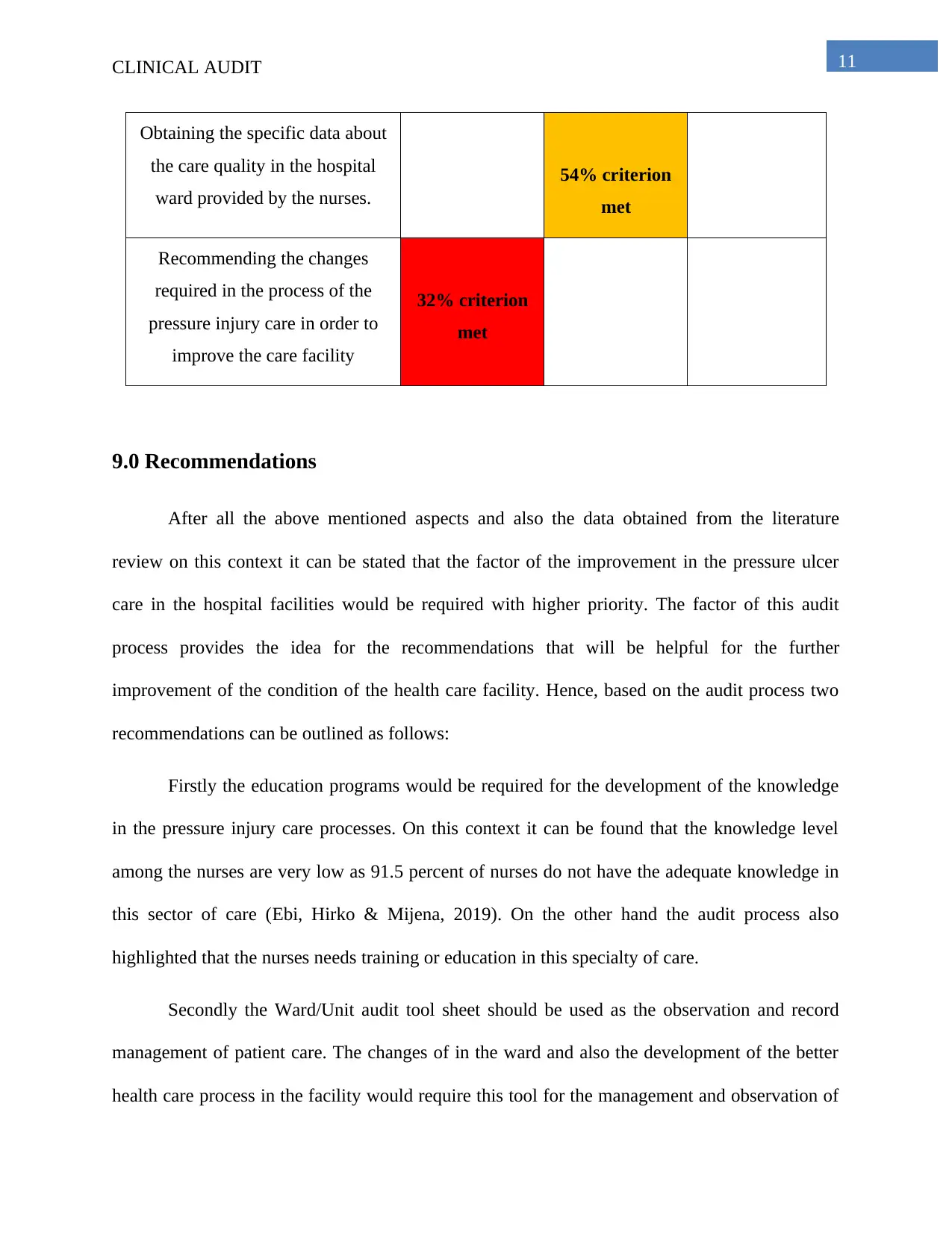
11CLINICAL AUDIT
Obtaining the specific data about
the care quality in the hospital
ward provided by the nurses.
54% criterion
met
Recommending the changes
required in the process of the
pressure injury care in order to
improve the care facility
32% criterion
met
9.0 Recommendations
After all the above mentioned aspects and also the data obtained from the literature
review on this context it can be stated that the factor of the improvement in the pressure ulcer
care in the hospital facilities would be required with higher priority. The factor of this audit
process provides the idea for the recommendations that will be helpful for the further
improvement of the condition of the health care facility. Hence, based on the audit process two
recommendations can be outlined as follows:
Firstly the education programs would be required for the development of the knowledge
in the pressure injury care processes. On this context it can be found that the knowledge level
among the nurses are very low as 91.5 percent of nurses do not have the adequate knowledge in
this sector of care (Ebi, Hirko & Mijena, 2019). On the other hand the audit process also
highlighted that the nurses needs training or education in this specialty of care.
Secondly the Ward/Unit audit tool sheet should be used as the observation and record
management of patient care. The changes of in the ward and also the development of the better
health care process in the facility would require this tool for the management and observation of
Obtaining the specific data about
the care quality in the hospital
ward provided by the nurses.
54% criterion
met
Recommending the changes
required in the process of the
pressure injury care in order to
improve the care facility
32% criterion
met
9.0 Recommendations
After all the above mentioned aspects and also the data obtained from the literature
review on this context it can be stated that the factor of the improvement in the pressure ulcer
care in the hospital facilities would be required with higher priority. The factor of this audit
process provides the idea for the recommendations that will be helpful for the further
improvement of the condition of the health care facility. Hence, based on the audit process two
recommendations can be outlined as follows:
Firstly the education programs would be required for the development of the knowledge
in the pressure injury care processes. On this context it can be found that the knowledge level
among the nurses are very low as 91.5 percent of nurses do not have the adequate knowledge in
this sector of care (Ebi, Hirko & Mijena, 2019). On the other hand the audit process also
highlighted that the nurses needs training or education in this specialty of care.
Secondly the Ward/Unit audit tool sheet should be used as the observation and record
management of patient care. The changes of in the ward and also the development of the better
health care process in the facility would require this tool for the management and observation of
⊘ This is a preview!⊘
Do you want full access?
Subscribe today to unlock all pages.

Trusted by 1+ million students worldwide
1 out of 16
Related Documents
Your All-in-One AI-Powered Toolkit for Academic Success.
+13062052269
info@desklib.com
Available 24*7 on WhatsApp / Email
![[object Object]](/_next/static/media/star-bottom.7253800d.svg)
Unlock your academic potential
Copyright © 2020–2025 A2Z Services. All Rights Reserved. Developed and managed by ZUCOL.




